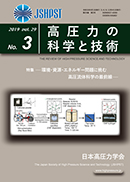
- 4 号 p. 239-
- 3 号 p. 169-
- 2 号 p. 73-
- 1 号 p. 1-
- |<
- <
- 1
- >
- >|
-
永井 隆哉2019 年29 巻3 号 p. 169-170
発行日: 2019年
公開日: 2019/10/05
ジャーナル フリーPDF形式でダウンロード (214K)
-
孔 昌一, 船造 俊孝, 三宅 浩史2019 年29 巻3 号 p. 172-180
発行日: 2019年
公開日: 2019/10/05
ジャーナル フリーDiffusion coefficients in supercritical fluids are of considerable importance in the design, optimization, scale-up and simulation of the newly proposed supercritical fluid processes. Here, the methods of measuring diffusion coefficients in supercritical fluids have been discussed. Various diffusion correlations have been presented as well. The reported diffusion data in supercritical carbon dioxide were mostly measured by the Taylor dispersion and the chromatographic impulse response (CIR) methods. It is found that most of the large and polar compounds have been studied by the CIR method.
抄録全体を表示PDF形式でダウンロード (334K) -
藤井 達也, 川﨑 慎一朗2019 年29 巻3 号 p. 181-186
発行日: 2019年
公開日: 2019/10/05
ジャーナル フリーIn this article, recent advances in the flow Liquid-Liquid (L-L) type extraction using high-pressure CO2 as extraction solvent are reviewed. It is described how flow L-L type extraction processes were achieved and their effectiveness in fast extraction and separation. Recent results obtained in our group, as well as those in literature, are summarized, and challenges for implementation in real flow-process are discussed.
抄録全体を表示PDF形式でダウンロード (552K) -
宇敷 育男2019 年29 巻3 号 p. 187-193
発行日: 2019年
公開日: 2019/10/05
ジャーナル フリーThis article reviews the thermodynamic modeling of solubilities of metal precursors in supercritical carbon dioxide for efficient preparations of supported catalysts using the PC-SAFT (perturbed chain-statistical associating fluid theory) equation of state. In this work, solubility data of acetylacetonate-type metal precursors were correlated using the PC-SAFT equation of state, then pure component parameters of the PC-SAFT (segment number, segment diameter, and dispersion energy) were obtained. The pure component PC-SAFT parameters depended strongly on the physical properties of the metal precursors, which could be generalized based on the physical meanings of the parameters. The generalized pure component parameters could predict the solubilities to within 30% average relative deviation under almost all conditions investigated.
抄録全体を表示PDF形式でダウンロード (666K) -
長田 光正2019 年29 巻3 号 p. 194-198
発行日: 2019年
公開日: 2019/10/05
ジャーナル フリーResearch in hydrothermal gelation of biomass-derived nanofiber dispersion is reviewed. In general, the gelation of biomass-derived nanofibers through conventional crosslinking or reprecipitation requires the use of additives. The preparation of a self-sustaining hydrogel from a biomass resource was achieved without any additives in hydrothermal gelation. Such additive-free hydrogels that can be shaped into diverse forms are promising for medical applications.
抄録全体を表示PDF形式でダウンロード (538K) -
山田 秀尚2019 年29 巻3 号 p. 199-205
発行日: 2019年
公開日: 2019/10/05
ジャーナル フリーResearch and development of CO2 capture technologies are of great importance in the context of global warming mitigation. Among those, amines are the most widely used compounds to remove CO2 from a gas stream. In this article, amine-based CO2 capture methods are briefly reviewed with a particular focus on amine-CO2 chemistry, CO2 solubility in amine solvent, and its pressure dependence. It is also described how the molecular structure of amine affects the CO2 absorption-desorption performance by comparing several amines.
抄録全体を表示PDF形式でダウンロード (622K) -
平賀 佑也, 渡邉 賢2019 年29 巻3 号 p. 206-216
発行日: 2019年
公開日: 2019/10/05
ジャーナル フリーIn our research group, resource conversion processes in high pressure solutions focusing on hydrothermal or ionic liquid as reaction and separation fields have been discussed. Specifically, we have examined kinetic study about enhancement of functionality and addition of higher value by breaking into low molecular weight materials from biomass using high pressure and high temperature water as solvent. For hydrothermal systems, our research groups have studied active control for pH in solutions as reaction controlling factors and utilization of solid acid/base. Additionally, development of recycling technique of positive-electrode material in lithium-ion batteries using function of organic acid in hydrothermal fields. For ionic liquid systems, our research group have studied extraction of reaction products and viscosity reduction effect for ionic liquid solution by adding CO2. Recently, physical properties of mixed ionic liquid systems which contain two or more ionic liquids have been measured and predicting method for them have been assessed. In this review, the results focusing on our research are overviewed, current research trends are introduced, and perspectives are discussed.
抄録全体を表示PDF形式でダウンロード (668K)
-
増野 いづみ2019 年29 巻3 号 p. 217-218
発行日: 2019年
公開日: 2019/10/05
ジャーナル フリーPDF形式でダウンロード (688K)
-
五味 斎2019 年29 巻3 号 p. 219-220
発行日: 2019年
公開日: 2019/10/05
ジャーナル フリーPDF形式でダウンロード (397K)
- |<
- <
- 1
- >
- >|